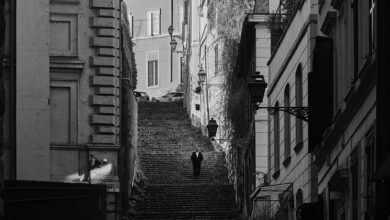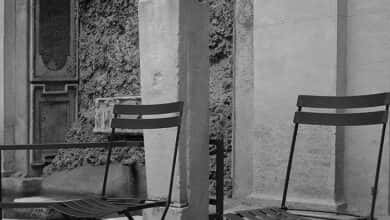Today, we can say that Venice has been seen from every angle. The city has been painted, photographed, filmed, etc., until it has become a reflection of its own image. Venice hardly ever surprises us anymore, yet the desire to immortalise it is always strong. Whether it’s its melancholy charm, its architecture, ‘suspended’ on the water, its light or, perhaps, the union of all these elements.

In Watermark, Joseph Brodsky describes the light in Venice, particularly in winter. A magical light, capable of ‘enhancing your eye’s power’. The light that passes through the windows calls to you and says: ‘Depict! Depict!’. Hearing this call, you can’t help but grab the camera and freeze the moment.
The view from the window, or from above, is a static opening onto the world because at that moment the environment is passively observed, sheltered from life, but this way of seeing still has its particularity and its charm: it is possible to see perspectives hidden during a habitual stroll or to catch a glimpse of the sinuous shape of the city.

Looking at the landscape, you can see the passage of time and the seasons: from the bright blue of the winter sky to the thick fog, from the golden rays of the sun to the autumn rain, from dawn to dusk, time passes and sets the pace of life. But the city stands still, as if trapped in its own history, in a never-ending spiral.

Its shape seems almost like a game of nature, but the harmony between the calli and the canals, its labyrinthine structure and its layout prove otherwise: the Venetians skilfully transformed the environment at their disposal.
In the beginning, and for a long time afterwards, economic, political and social life was marked, in a certain sense, by the structure of the urban plan and its development: the regular repetition of the campo – church – school, the buildings built along the Grand Canal, the Arsenal, the commercial areas, the satellite islands, etc., all arranged in such a way as to facilitate the life of the vast community.
In reality, all this was the reflection of a political power that, during the Republic, had a very specific objective: to maintain prosperity, power and security through innovative and brilliant management of the city. However, this innovation was also accompanied by oppressive methods, such as plotting, murder and population control.
Beneath the ‘aesthetic glories’ of Venice, a dark and controversial world opens up. The weight of history, however subtle, is felt. Venice reflects its history and its soul: an intense and unstoppable beauty, fragile and tormented at the same time.

Venice is the city of contradiction in so many ways, too many to list, but it’s probably all its contradictions that make it unique and special. It’s hard to say what the fate of Venice will be: many times it has fallen, many times it has risen. Certainly, Venice needs a lot of care, which it is not given.
This series is a floating path over the rooftops of Venice, over familiar sights or unusual ones: it’s a tear in a sea of images.












